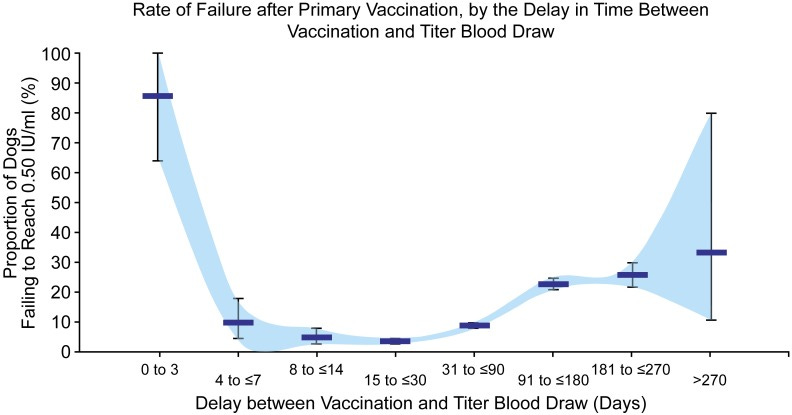So you take your pet in for a rabies vaccine. They are injected with some serum, bypassing all of their immune system’s natural skin and mucosal defenses, but this would presumably be the case of they were bitten by another animal too. Hopefully they live and seem okay after this injection and perhaps other subsequent booster doses.
To prove that your pet is immune the dog or cat might be required to have a blood titer test done following rabies vaccination in order to enter certain jurisdictions. With this they are testing for the very same “virus” which could be a poison, a byproduct of other healing and clearing processes, or something else. Now if your pet tests positive for rabies, they are considered to have built antibodies against the disease, which is considered a good thing. Hooray! Now you can take Fido to Hawaii, or New Zealand, America, or wherever you wanted to go with them. A microchip may also be required, or else the rabies vaccines do not work.
Antibodies, it turns out, are a very tricky thing, seeming more like a poison the body is trying to clear the more I read of it. For example some dogs do not test positive for rabies following vaccination. As per this NIH article:
A rabies neutralizing antibody titer ≥ 0.5 IU/ml is defined by WHO and OIE as the minimum post-vaccination antibody level [1,7]. However, several studies have reported that roughly 10% of rabies vaccine naïve dogs fail to reach this threshold after primary vaccination [8,9].
The failure rate of the rabies jab to produce antibodies in dogs was correlated with the time of the test, but note that the vaccine was never 100% successful. What are labelled “antibodies” to rabies also drop off markedly 270 days or nine months after the last booster dose, with an average of 30% of dogs then failing the titer test. So much for lifelong protection for your pet.
Those titer tests should only be done in a certain window from 3 to 90 days post rabies vaccination. So your pet, if testing positive, is presumed to have built a tolerance for the rabies virus which they then call immunity. It turns out people can develop an immunity for snake venom too. Sort of.
The official logo of the World Health Organization. This image is also used to prove that the Earth is flat for those who align with that theory. To me it symbolizes “deception abounds.”
The caduceus of Hermes
The term ‘caduceus’ comes from a Greek word meaning ‘herald’s wand’ and refers to the staff carried by the ancient Greek god Hermes – called Mercury by the ancient Romans. He was messenger of the gods, protector of travellers, shepherds and merchants, as well as the protector of thieves, liars and gamblers.
The Rod of Asclepius
Several sources claim that Asclepius (Aesculapius for the ancient Romans) was first a physician hero, who was later recognised as the god of healing with a cult that spread in the 5th century BCE. Various sanctuaries in his name were built throughout Greece as areas of worship and refuges for the ill. These were hospital-like places where priests guided patients through rituals of purification and medical curative practices, regularly involving snakes as part of the healing process.
You might be wondering what snakes and snakebites have to do with rabies. They have never called antivenin or antivenom a vaccine, but both are often given after a bite to build immunity somehow. In March of 2021 I was forced to do an emergency deep dive on snake antivenim, or antivenom. I am intentionally using the various spellings interchangeably here.
Some of my long time readers, especially in the Thai expat community, have probably seen my article about that time that my husband got bitten by a viper in 2021. I wrote a guest post in theThaiger regarding this. Unfortunately it was my only collumn I wrote for that news outlet, as I am pretty sure that theThaiger editors caught wind of my antivax sentiments in their forum afterwards. This was in April of 2021, when the Covid injection campaign was ramping up and censorship of any critical questions or perspectives about it was at a fever pitch. To me it was beyond obvious in Thailand that the injection campaign’s kickoff coincided with Covid outbreaks which were then used to double down on the same failed lockdown/ closure/facemask policies until everyone was jabbed. I proposed a few other articles to theThaiger regarding growing and harvesting practices in Thailand, staying on a highly naturalistic bend which had nothing to do with vaccines in my submissions, but I never heard back from them again.
Now here’s a sort of rest of the story regarding my husband being bitten by a pit viper. Some years prior, due to a close encounter I had with another viper, I had decided to research the deadly venomous snakes in Thailand. I wanted to be able to visually identify them quickly, in case they bit either me or a family member and slithered away, so that I or my family member could receive appropriate medical treatment such as snake antivenim. There is no universal antivenom the formulation depends on the species of snake. I assumed, unthinkingly, that this treatment would save mine or a loved one’s life. Antivenom, antibodies, antidote, it’s all the same, right?
There are many colabrand snakes here, which are venomous, but not usually lethal, and which most hospitals do not carry antivenim for. Apparently they have a difficult time biting humans and are usually not aggressive. So I focused on the three most deadly classes, which here in Phuket are listed as cobras, vipers and kraits.
I still haven’t seen a krait snake, which is most obvious by it’s black and (usually yellow) banded markings. I’ve found a few Laiotian wolf snakes that engaged in mimicry of the Krait’s markings, but which were nonvenomous and much smaller. Cobras and vipers, however, have been encountered by me several times. Cobras are distinguished by their hood of course when they are flairing up as one did to my cat Sprout last year (that one got away). They also have sort of oval scales if seen in the sun and often a distinctive marking on the back of their head which marks the type of cobra. Vipers, meanwhile, come in practically every color combination you can imagine for a snake but have a very distinctive triangulated head that is well out of proportion to their size.
This snake didn’t slither away, being that my husband killed it. So I am pretty sure on the identification of the type.
In 2021 I am about 95% sure that my husband Ka was bitten by a viper. Yet he adamantly refused medical treatment for this bite by a deadly venomous snake.
That threw all my careful research on snakes out of the window. Why would Ka not want snake antivenim? Or hospital treatment in general, for that matter? My husband insisted that this had been a dry bite with no poison, but how would he know that?
I stayed up until dawn researching after this incident while occassionally checking on my husband, who went back to sleep shortly after the middle of the night encounter. The dead snake and the uproar had led to some neighbors gathering around after the snake had stopped slithering. They seemed in awe of it and one neighbor asked to take the dead snake that night. The pit viper was never seen again. This lends credence to my belief that it was venomous, as it is considered something of bragging rights to kill a legitimate deadly snake in those outback areas. Most likely the neighbor claimed the kill as his own.
TheThaiger article uses a stock photo of a Pope’s pit viper, but I did manage one picture of the actual dead snake that March night in 2021 where my phone flash went off before the viper was taken away. Any snake enthusiasts are welcome to tell me if my classification is wrong here. It looked like a dark green pit viper to me.
It turns out that rabies vaccination after a bite and snake antivenim after a bite have a lot in common. A quick Google search for who produced the first Antivenom gave me this result:
French scientist and physician Albert Calmette is credited with creating the first snake antivenom. Renowned chemist Louis Pasteur met Calmette in Paris in 1890, and, impressed by his work, invited him to organize rabies and smallpox vaccination campaigns at The Pasteur Institute in Saigon.
As mentioned in Rabies Part 3, Louis Pasteur was responsible for the first production of the rabies vaccines. Could similar funny science have been employed here?
Rabies Part 3
I seemed to have hit a stall in this series when I tried to determine what was in a rabies vaccine due to the many formulations, so I decided to dig into the history of rabies and of rabies vaccination. SARS CoV2 rabies is not, meaning that it is far from a supposedly novel disease possibly made worse by some mad scientists tinkering in a lab with something. A quick Google search indicates that rabies was first mentioned in the fifth century as being something to guard against from excessively salivating dogs. Long before anyone was peering into a microscope at brain tissue there was a encephalitic disease that appeared in some people after being bitten by certain animals.
Here’s a photo of the poor dead viper:
Keep reading with a 7-day free trial
Subscribe to Amy’s Newsletter to keep reading this post and get 7 days of free access to the full post archives.






